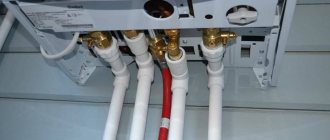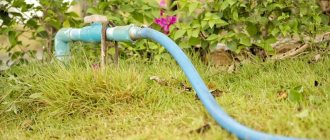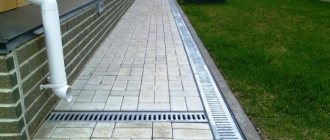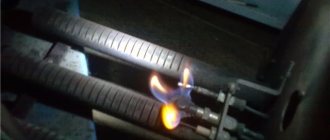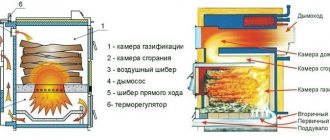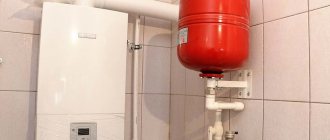From the author: hello, friends! Piping a heating boiler with polypropylene is done quite often, since these pipes have many advantages. But still, some owners of private houses sometimes have doubts about this.
Polypropylene is a relatively new material. At least it cannot be said that it has been used for centuries. Therefore, sometimes there are concerns about how durable it is, how it can withstand various aggressive conditions - after all, in this case we are talking about working with high temperatures.
It is worth saying right away that all these fears are, in general, groundless. If you choose the right pipes and do the piping correctly, you will get a very high-quality, reliable and durable heating system. Therefore, let's understand the nuances so that all this no longer raises questions for you.
Polypropylene pipes in heating systems
Fittings and pipes made of polypropylene (PPR) are popular due to their low cost and ease of installation. They are not subject to corrosion, have smooth internal walls and serve no less than the 50 years declared by the manufacturer.
There are several types of these pipe products, which differ in technical characteristics and purpose.
In the construction of heating systems, as well as in the installation of hot water supply circuits similar to them in operational parameters, the following is used:
- Pipes marked PN 25. Products with reinforcement made of aluminum foil. Used in systems with nominal pressure up to 2.5 MPa. Operating temperature limit +95º C.
- Pipes marked PN 20. Reinforced version used in DHW branches of double-circuit heating boilers. They will work for the period stated by the manufacturer if the coolant temperature is not higher than +80º C and the pressure is not higher than 2 MPa.
- Pipes marked PN 10. Thin-walled polymer products. They are used if the boiler supplies coolant to the water heated floor system. Operating temperature not higher than +45º C, nominal pressure up to 1 MPa.
Polymer pipes are suitable for all known installation methods: open and hidden. But this material has a high coefficient of thermal expansion. When heated, such products begin to slightly increase in length. This effect is called thermal linear expansion and must be taken into account when constructing pipelines.
The boiler should be tied with polypropylene pipes, which are marked as operating class 5, operating pressure of 4–6 atmospheres and nominal pressure PN of 25 and above
To prevent destruction of polypropylene heating pipelines, compensation loops can be installed. But it’s easier to take multilayer pipes, the reinforcement in which is specifically designed to compensate for this stretching. A layer of foil inside PN 25 polypropylene pipes reduces their thermal elongation by half, and fiberglass by five times.
Image gallery
Photo from
Large diameter PP pipe welding machine
Features of welding wide plastic pipes
Connection of narrow polypropylene pipes
Apparatus for connecting small diameter PP pipes
Safety valves
They are not used when the heating system is open. The purpose of the valve is to protect the boiler from damage in the event of a sudden increase in pressure.
Usually the valve is forgotten or a model or safety group with different characteristics is installed. When the valve responds, some of the water flows out of the system, providing pressure relief and protection. You should not insert the drain tube into the sewer, since the reason for the decrease in pressure will not be clear. You can get by with a funnel. By the way, there is no need to throw the septic tank into the coolant.
Air vent
. The part must be installed immediately after installing the boiler to avoid “airing”. Often they simply forget to open it. This is also typical for wall-mounted options with a factory function. By the way, the circulation pump is also ventilated.
The air vent must stand strictly vertically upward. When it starts to leak, there is a shut-off valve in front of it, so replacing it with a new one will take a couple of minutes.
Circulation pump
. The pump will operate properly only when the axis is in a horizontal position, and this position will significantly extend the “life” of the bearings.
It is advisable to protect the mechanism from dirt and debris from the outside. Strainers sold separately
Radiators.
Disadvantages when connecting a panel radiator to the coolant. The radiator design involves connecting the supply pipe to the internal vent, located almost in the center, and to the outermost one - in the return pipe. The reverse connection order will reduce the heat transfer of the radiator by half. By the way, decorative screens disrupt heat transfer by 10-20%.
Proper installation and correct power calculations will help create maximum comfort for living in a country house at any time of the year.
Features of installation of PPR pipelines
When piping a boiler, polypropylene pipes and fittings are connected mainly by cold or hot welding; when connecting to metal pipelines, threaded connections are used. Screwing on is much more convenient, but because of them, assembling the system will cost significantly more.
True, if you want to connect a polypropylene pipeline to a metal counterpart, you cannot do without threaded fittings.
An extensive line of fittings is produced to form linear and nodal connections of polypropylene pipes
“Hot” welding is done with a special apparatus (soldering iron, “iron”). The pipes are heated using a suitable nozzle to a melting temperature of 260 degrees, and then the parts with softened edges are pressed against each other. The result is a reliable and monolithic connection.
Before welding, the foil of reinforced pipes must be cleaned. Otherwise, it will interfere with the connection of polymer products, making the seam fragile. With fiberglass, these unnecessary steps will not be required. It melts easily along with the plastic.
PPR soldering technology is extremely simple, all work can be done with your own hands (+)
Cold welding involves the use of a specialized adhesive composition. In recent years, this method has rarely been used, because the result is not reliable enough.
In heating systems, threaded connections should be sealed with paronite or high-temperature sealant. Do not forget about the fairly high operating temperature of the coolant.
There is one more nuance of using polypropylene for piping a heating boiler. Antifreeze and plastic are a pretty bad combination. It is recommended to use water as a coolant for a system of plastic pipes.
How and what to seal pipe joints with
Types of seals, sealing methods
To prevent leakage of the pipeline working fluid, it is necessary to properly seal the pipe twists.
When threading steel pipes, the following are used as seals:
- gasket This method of sealing a threaded connection requires relatively thick end pipe cuts. The presence of smooth pipe ends can never ensure tightness. When using a rubber or plastic gasket, this problem is successfully solved. This option is ideal in case of articulation using a union nut;
- winding The materials can be linen strands, polymer threads, FUM tapes in combination with hardening sealants, paints, pastes.
When installing plastic risers, a sealing method is used based on the deformation properties of the material. The essence of this method is that a plastic pipe with an external thread is screwed into a riser with an internal thread. During deformation, plastic contributes to excellent filling of the intermediate space, eliminating the appearance of gaps.
When it comes to pipeline structures with high pressure, cylindrical threaded pipe connections are not entirely appropriate here. In such cases, a conical type connection is used. The principle of connection is that when screwing in, the pipes are tightly pressed until the gap completely disappears.
Materials for sealing joints
To make the joint impenetrable, the following are used as seals:
- flax (tow);
- asbestos;
- FUM tape;
- natural drying oil;
- whitewash;
- minium;
- graphite lubricant, etc.
A reliable sealant when twisting steel pipes onto threads is strands of flax impregnated with red lead or white lead. This connection is easy to install and reliable in terms of sealing. The seal has been used for a very long time and does not lose its popularity today, despite the emergence of artificial analogues.
For those who have little experience in installing fittings and pipes, we suggest that under no circumstances use flax without paint.
At first, the joint will not allow moisture to pass through. But several months will pass, the flax fibers will get wet and begin to decompose. Therefore, the quality of all connections will deteriorate, and in another month or two, water will leak at the junction.
Many people use FUM tape, which is in no way inferior to old traditional materials - tow with paint.
Sometimes there is no tightness at the junction of the risers. To eliminate this defect, you need to replace the sealing material, and clean the threaded area from dirt and sealant residues. After this, rewind the linen thread, FUM tape or other sealant, and assemble the structure.
Pastes and sealants of chemical origin are used as additional sealants, which will help strengthen this section of the pipeline.
Selecting a heating system wiring diagram
There are several options for lining the boiler with polypropylene. This scheme is selected individually for each house. What is optimal in one building may be ineffective in another.
In addition, heating systems based on the principle of water movement are divided into: forced with a hydraulic pump and gravity (gravity, natural), there is also a classification based on the construction of pipelines. According to their structure, they are single- and double-pipe, collector beam or analogues with closed rings.
Which is better: gravity or pump?
In the gravity circuit, heated water flows from the boiler to the radiators by gravity. A hot coolant that has a high temperature always tends to replace a colder liquid. This heating boiler piping system is the easiest to assemble. In addition to the heater, it contains polypropylene pipes, radiators and an expansion tank.
In the version with top distribution, water, after heating, rises to the highest point - into the expander, and from there it goes down to the batteries. After the heat is released, it returns to the boiler, where it is heated again, then starting a new cycle.
This is how heating is installed in many houses in our country’s villages. Only there is a solid fuel stove. This is the simplest and cheapest way to organize heating for a small cottage. However, it has limitations both in the number of connected radiators and in the distance of the outermost one from the water heater.
The piping scheme with natural water movement is the simplest of all possible options, it has a minimum of nodes and connection points for polypropylene pipes
The compulsory system is more complex and expensive. However, it greatly simplifies the creation of comfortable temperatures in individual rooms. The coolant moves in it due to the stimulation of its movement by the pump.
The choice of polypropylene pipe layout and the boiler itself are closely related. The natural circulation system is energy independent. If the water heater does not require power from the electrical network, then even during power outages the house will be heated.
In a forced circuit, the pump requires a constant power supply to operate. Therefore, it is best to select a boiler for it that is dependent on electricity, which has additional capabilities. But in order to insure against voltage problems, you will have to purchase a backup generator or uninterruptible power supply.
Which heating scheme is better to choose?
There are many ways to route polypropylene pipelines from the boiler to the heating radiators.
But all these schemes are divided into:
- single-pipe;
- two-pipe.
In single-pipe systems, heated water supplied as a coolant is supplied and discharged through one pipe. In two-pipe systems for supplying coolant and return, i.e. to drain cooled water back into the boiler for heating, separate lines are constructed.
According to the method of connecting the working components, heating circuits are divided into:
- tee;
- collector
Tee types can be used for both gravity and forced circulation. The collector circuit can only work if there is a circulation pump.
A single-pipe circuit is obviously cheaper than a two-pipe circuit, but the radiator farthest in the chain from the boiler receives a minimum of thermal energy (+)
The single-pipe method involves laying one looped line and connecting batteries in series to it. In a two-pipe scheme, two independent pipelines with hot water and return flow from the boiler. And radiators are already connected to them.
With collector piping, one or two collectors are built into the system, from which separate pipes are routed to each battery. Also, such a distributor allows you to connect a “warm floor” made of the same PPR to the boiler.
Collector wiring makes it possible to create efficient heating systems for houses of large area and different number of storeys (+)
The use of collectors and separate risers for each battery leads to a significant increase in the cost of both design and installation. At the project preparation stage, more complex calculations have to be made. And during assembly, a much larger volume of polypropylene is consumed. But what we get is a system, each part of which can be adjusted to specific conditions and requirements.
Options for piping boiler equipment
The source of all heat supply systems is the boiler. It heats the supply coolant usually to T 95 C in the heating system and to T 65 C in the hot water supply, using gaseous, liquid or solid fuel for combustion. The boiler is a dangerous piece of equipment, especially when operating on gas fuel. Its efficient and safe operation can only be ensured by proper harnessing. Particular attention is paid to solid-state heat supply sources that do not have automation systems. Their correct piping will not only create a boiler safety system, but will also allow achieving efficiency at the level of a modern gas unit. Tying a heating boiler with polypropylene, project diagrams, depend on the design of the boiler and the type of network.
READ ALSO: How to Fill Polypropylene Heating Pipes in a Screed
With forced circulation
This option for moving water along the boiler circuit is more preferable, especially for heating multi-level buildings of a huge area, where it is necessary to overcome large hydraulic resistance in the network. This is a more modern heating supply scheme, since it allows you to fully automate the heating process, including achieving different temperature conditions in the room.
The only drawback of this type of heating is its energy dependence on the electrical network, without which pumps, smoke exhausters and the control unit will not be able to function. In the traditional version of the harness, balancing of auxiliary equipment, safety automation and regulation is performed. Polypropylene piping of a double-circuit boiler is carried out separately for the heating and hot water circuits.
There are simplified installation schemes using the primary-secondary ring method, which reduces the number of devices, but each ring will need to be equipped with an autonomous pump. A floor-standing double-circuit boiler operating on a system of several rings with a power of up to 50.0 kW is equipped with collectors, called combs, which ensure a uniform supply of heat flows.
With natural circulation
Gravity boilers are considered the simplest to make the piping yourself. A characteristic feature is the absence of a pump that ensures the movement of the medium through the heating circuit. The movement of the medium to the heating devices and its return to the boiler unit for a repeated heating cycle is accomplished thanks to the physical laws of movement of media of different temperatures. A similar piping scheme is well applicable for heating small garden houses; it can be done by almost anyone who can hold a tool in their hands.
- Boiler;
- radiators made of cast iron, steel, bimetallic or aluminum;
- hydraulic expansion tank with membrane;
- PPR polypropylene pipes;
- bypass line made of PPR, to turn off heating appliances.
Advantages of piping gravity boilers:
- Quick, simple assembly of the heating circuit;
- small number of auxiliary devices and fittings;
- non-volatile operation of the circuit;
- budget price for equipment configuration and installation;
- the ability to carry out repairs yourself.
The disadvantages include the accuracy of calculating the diameter of the pipes and ensuring their slopes when it is necessary to connect the circuit with natural circulation. The diameters are large, which does not add design to the premises; in addition, the system is configured for maximum performance and is practically not adjustable. However, when the owner gets tired of all this, he can easily install an energy-efficient, small-sized pump into the circuit.
Polypropylene circuit for different boilers
Most manufacturers of water heaters recommend making the first meter of the pipeline from metal. This is especially true for solid fuel devices with a higher outlet water temperature. When piping, polypropylene should be connected to this outlet, otherwise if the boiler malfunctions, it will suffer a thermal shock and may burst.
Option #1: Gas water heater
It is recommended to piping a gas boiler with polypropylene using a hydraulic arrow and a manifold. Often, gas models are already equipped with built-in pumps for pumping water. Almost all of them are originally intended for compulsory systems.
The most reliable in terms of safety will be a scheme with circulation equipment for each circuit behind the collector.
In this case, the built-in pump will pressurize a small section of the pipeline from the boiler to the distributor, and then additional pumps will be used. They will bear the main burden of pumping coolant.
You can tie a gas boiler with polypropylene without long metal pipes; the water in such a heater rarely heats up to 75–80 degrees
If the gas boiler has a cast iron heat exchanger, then when piping it into the system, an additional heat accumulator should be installed. It will smooth out sudden changes in water temperature, which have a negative effect on cast iron. If the coolant is heated or cooled abruptly, it may even burst.
When piping a double-circuit device with parallel heating of water for domestic hot water, additional fine and coarse filters will have to be installed on this outlet. They should be mounted at the entrance to the water heater, where cold water is supplied.
Option #2: Solid fuel model
The main feature of a solid fuel boiler is its inertness when the fuel supply is stopped. Until everything in the firebox burns out completely, it will continue to heat the coolant. And this can have a detrimental effect on polypropylene.
When piping a solid fuel boiler, only metal pipes should be connected to it immediately, and polypropylene pipes can only be inserted after a meter and a half. In addition to this, it is necessary to provide a backup supply of cold water for emergency cooling of the heat exchanger, as well as its discharge to the sewer.
The section of the pipeline from the solid fuel boiler to the collector should be made of metal, and then you can tie it with polypropylene - this is the only way to protect the plastic pipes from overheating
If the system is built on forced circulation, then it will be necessary to install an uninterruptible power supply for the pump. Water must constantly remove heat from the firebox where solid fuel burns, even during power outages.
In addition to it, you can make a small gravity circuit or equip all batteries with bypasses to turn off individual sections of the system. In case of accidents, this will allow you to repair the damaged section while the heating is running.
The solid fuel boiler must be covered with a protective casing, which limits the spread of heat from the walls of the firebox into the boiler room. But even if it is present, the manifold and plastic pipes should be removed away from the stove.
Option #3: Oil and Electric Heaters
The exhaust or diesel boiler is wrapped with polypropylene according to a scheme identical to its solid fuel counterpart. The polymer must be removed from it as far as possible.
When piping an electric PPR boiler, you don’t have to worry about pipe ruptures; it has an automatic safety device that prevents the water from boiling.
Heating the coolant in an electric water heater to critical temperatures for polypropylene is practically impossible. When the voltage goes out, it simply stops working. In this case, the pipes are protected from hydraulic shocks by a hydraulic accumulator and valves to relieve excess pressure.
What to choose
It is believed that the choice of PN25 pipes should correspond to the cost of boiler equipment. For cheap wood burning, you can use Chinese pipes. But not the first ones that come to hand, but those that are produced in China under a license from one of the European Union countries, made from imported raw materials using original equipment. For example, the “BLUE OCEAN” brand.
To piping a double-circuit boiler with polypropylene, you can use German products from Banninger or Italian pipes from Valtec. Among the cheaper ones, we can recommend high-quality polypropylene from. They are not capricious during installation and tolerate low temperatures well. Vesbo is the best Turkish pipe for piping.
Did you choose the pipes for piping the boiler yourself?
Purpose of fountain fittings
Devices of this class are responsible for solving the following engineering and technical problems:
- ensuring well sealing;
- diversion of products transported through the pipeline system;
- to adjust and maintain well flow;
- when providing access to the well bottom;
- to ensure sampling without stopping production processes.
Products of this class are used at high pressures arising under the influence of loads. Fittings are used when there is a possibility of exposure to aggressive environments inside the well. Quite often it is used if the liquid contains a large number of impurities of different origins and sizes.
When using such a system, it is necessary to take into account that this equipment must have a long service life and the necessary margin of safety. The main consumers of these products are enterprises engaged in the production and transportation of hydrocarbons, as well as the construction of pipeline transport systems.
Christmas tree fittings - tee type
The tee-type fountain fittings have two tees: the upper one is the working one, the lower one is the backup one.
The tee-type Christmas tree fittings have nominal bores of 50 and 90 mm.
The tee-type fountain fittings have two tees: the upper one is working, the lower one is a backup one, which is used only during repair or replacement of the upper one. Reinforcement of this type has a large height (up to 5 m from the ground surface), is inconvenient to maintain, and is unbalanced. It is used in particularly difficult well operating conditions - in the presence of solid suspensions in the gas flow that cause abrasive wear of equipment, gaseous or liquid corrosive agents (carbon dioxide, hydrogen sulfide, propionic, butyric or other fatty acids), with sharp fluctuations in pressure and temperature.
The wellhead is equipped with a special twin tee-type Christmas tree with two-string flow lines for each formation. There are a number of modifications of well equipment according to the fountain-gushing scheme, adapted for various operating conditions.
| Scheme of cross fountain fittings. |
In sand production wells, a tee-type X-mas tree is used. Instead of a cross 7, a tee (not shown in the figure) with a spare flow line is installed on the central valve 6, then an intermediate valve and a tee with a working flow line.
The well's surface equipment is a special double X-mas tree of the tee type with nominal bores of 50 and 40 mm in diameter and with two-string discharges for each formation (Fig. XIII. The fittings are designed for an operating pressure of 20 0 MPa. Equipment with parallel placement of tubing pipes is used in wells with a production casing with a diameter of 168 mm or more.
Deep gas-condensate wells are equipped with an AF-60-300 tee-type (two-string) Xmas tree in a flanged design, designed for GOO am test pressure and 300 am operating pressure.
To test a well equipped with a tee-type X-mas tree, a line must be laid from the bottom string of the valve for installing a diaphragm critical flow meter (prover), and a purge line must be laid from the top string.
To test a well equipped with a tee-type Xmas tree, a line for installing the prover must be laid from the bottom string of the fixture, and a purge line must be laid from the top string. If the fountain fittings are of the cross type, then a line must be laid from one string, and a blow-off line from the other.
In accordance with GOST 13846 - 89, tee-type Christmas tree fittings are produced for operating pressures of 14, 21, 35, 70 and 105 MPa. Christmas trees with bore diameters of 100 - 150 mm are designed for high-yield oil and gas wells.
After completing the well killing work, the AFT2 - 21/2x320 tee type Xmas tree should be dismantled, having previously disconnected it from the pipeline. At the wellhead, install a preventer installation in accordance with Scheme 2 according to GOST 13862 - 90 and remove the lift string from the well, inspect the pumping and compressor pipes.
| Wellhead piping and location of surface equipment during well development in the Stavropolneftegaz association. |
When developing wells with a depth of 1000 - 1500 m, a Christmas tree with a bore of 50 mm is used - 1AFT50, 2AFT50, etc., in Fig. IV.10 shows a diagram of the piping of the wellhead with the 2AFT50 Xmas tree and the location of ground equipment during the development and exploration of wells in the Pyatigorsk geological prospecting expedition of the Stavropolneftegaz association. At the wellhead, a tee-type christmas tree with a pressure of 12–5 MPa is installed. The upper string is directed to the gas separator and to the torch, and the lower string is directed only to the torch. From the gas separator, the liquid enters the measuring tank, and the gas, after measuring using a prover, goes to the torch. The upper string contains a fitting chamber, a rock collector, a pressure gauge and a pocket for a thermometer. The gas separator is installed at a distance of 50 m from the Christmas tree fittings.
| Wellhead piping and location of surface equipment during well development in the Stavropolneftegaz association. |
Rules for installing solid fuel boilers
Before connecting a solid fuel boiler, you should know that the following requirements apply to the installation of units of this type:
- Professional installation of pipes and radiators. Only in this case can you count on the correct operation of the heating system and the correct connection of a solid fuel boiler that has an input and output for connecting the rest of the circuit.
- Presence of a certain temperature. The greatest efficiency of a solid fuel boiler is possible only at an outlet temperature of 55 degrees and an inlet temperature of 45 degrees. With these same indicators, you can count on the longest possible period of flawless operation. A different temperature in the system can cause condensation to form, which has a destructive effect on metal parts.
Correct installation of the boiler
It is very important to understand the rule of how to connect a solid fuel heating boiler. The unit should be placed on a rigid base in a strictly vertical position
As a platform, you can use a cement screed with a thickness of at least 5 cm with bedding of the same height. For solid fuel boilers, it is recommended to use an open expansion tank, which should be located at a higher level than the entire heating system. The best option for this part of the system is the attic.
A properly equipped chimney. Mandatory conditions for a chimney include the following: the presence of a stainless steel valve and a condensate collector at the bottom of the chimney. In addition, it is necessary to have special hatches that provide access to clean the channel from soot. That part of the pipe that will pass through an unheated room requires careful insulation. This will help increase the service life of the chimney pipe.
The piping diagram of a solid fuel boiler must necessarily contain a safety valve. It is recommended to connect a water circuit in which the pressure does not exceed 0.2 MPa, and the temperature of the working environment cannot be higher than 90 degrees.
Design
The production of fittings, according to GOST 13846-84, involves the use of tee and cross type schemes.
The device consists of:
data-ad-client=»ca-pub-8514915293567855″ data-ad-slot=»1955705077″>
- pipe head;
- fountain tree;
- manually operated locking devices;
- chokes.
The pipe head is used to hang several rows of tubing and seal them. In addition, the pipe head takes part in technological operations, which include: development, operation and repair of the well.
Hanging of columns is carried out (on a thread):
- if a single-row elevator - on the coil thread;
- if there is a two-row elevator: the inner column is on the thread of the coil, the outer column is on the thread of the crosspiece of the pipe head.
The pipe head requires replacement of its side valves. This process is carried out using special blind plugs, which are installed in the threaded holes of the housing.
Shut-off devices on fountain fittings with manual control
Christmas tree functions:
- directs product to the flow line;
- takes part in the installation of special devices;
- measurements of pressure and temperature of the environment;
- lowering downhole instruments for pipe cleaning.
Shut-off devices are presented in the form of straight-through plug valves and direct-flow valves with a lubricant supply. Their main purpose is to cover passage holes.
Column heads serve as casing hanger, sealing and pressure control between pipe strings. to menu
Technical requirements for design
GOST 13846-89 defines a Christmas tree as a device designed to seal wells, shut off the medium and direct it to the manifold, and carry out other technological operations.
According to GOST 16350-80, fountain fittings can be used in temperate and cold macroclimatic regions. Placement is carried out according to category 1 (GOST 15150-69).
Optimal ambient temperature: from -60ºC to +40ºC.
High-quality fittings are durable and can withstand atmospheric loads
GOST 51365-2009 established the use of a certain material and the level of technical requirements that are most suitable for operating conditions.
The production of parts can be designed according to individual orders, taking into account that all operating conditions and the choice of component materials will comply with established standards. to menu
Designation AFK
- AF – fountain fittings;
- K – method of hanging the pipeline according to GOST 13846-84;
- n – scheme according to GOST 13846-84 (n = 1-6);
- E – cable entry;
- 65×21 – nominal diameter and working pressure in MPa;
- HL – climatic versions of the product;
- K1 – corrosion resistance category.
Typical schemes according to GOST 13846-89:
- AF1, AFK 1;
- AF2, AFK 2;
- AF3, AFK 3;
- AF4, AFK 4;
- AF5, AFK 5;
- AF6, AFK 6.
to menu
Elements of the make-up device
The recharge scheme for heating networks will depend on the hourly productivity of the standard recharge. For large main heating networks, in which the standard recharge is hundreds and sometimes thousands of cubic meters of water per hour, the complex includes: a water tank, chemical water treatment, automation, electric pump and shut-off and control valves. When performance decreases, the number of circuit elements can be significantly changed.
System recharge unit
Boiler gearbox
The reducer is installed on the return pipeline in front of the boiler to supply make-up water to the network circuit. Water from the city water supply flows through the valve when the pressure in the network pipeline drops due to leaks or release of an air lock. If the diagram provides for the installation of a circulation pump, then it is installed second. Otherwise, the operation of the entire heating system may be disrupted.
The gearbox operates automatically without maintenance personnel. Sometimes this is not always convenient, since it is impossible to control the leak, and its size can reach emergency proportions. Therefore, many users prefer manual recharge mode or install systems with alarms for high leakage levels.
Pump group
One or more pumps supply make-up water in front of the boiler units at a pressure higher than that in the return network water. The pump is activated by a pressure sensor and supplies water from the make-up water tank.
There are schemes with a submersible pump that can take water from a well or well. The pump group is calculated based on the hourly productivity of the standard make-up; the number of electric pumps must be at least 2, one of which is a reserve one.
Diagram of a heating system with make-up
Actuating mechanism
It is installed to control the valve on the make-up line. Usually it is included in the make-up unit, consisting of a shut-off and check valve. It has electrical contacts for sending a signal to control the pump. The mechanism is adjusted to the permissible operating pressure. The actuator is usually a valve with an electric motor.
As it is filled, the pressure reaches the operating value, the sensor gives a signal to close the valve, the electric motor of which begins to rotate in the opposite direction.
Check valve
This is a mandatory element for any make-up scheme, since it prevents network water from entering the city water supply or water tank, which can lead to contamination of the tap water and an emergency shutdown of the boiler unit.
Backflow of water can occur even during make-up, if the pressure in the city water supply is lower than in the return, or when the shut-off and control valves do not ensure tight closure. The check valve is installed after the actuator.
In the retail chain there are options when it is built into the pressure reducing valve body. Currently, the make-up unit is equipped with a check valve in front or a “flow breaker” is used.
Makeup water purification filters
Impurities in raw water have a bad effect on the operation of heating equipment, especially the boiler, and can be deposited on boiler heating surfaces in the form of scale and sludge, reducing the coolant circulation rate and causing overheating in the boiler, followed by pipe rupture.
Simpler cleaning is performed using mechanical filters filled with sand or activated carbon. Simpler devices can also be installed - mud collectors, in which mesh filters are installed and have a larger body diameter than that of the return pipes. Water enters the mud basin, its speed drops and suspended solids precipitate. More complex hardness salts must be removed in specialized softener filters.
Common problems and errors
Low efficiency and frequent breakdowns of heating equipment are a clear sign of mistakes made during its installation.
Mistake #1. Most often, problems arise due to insufficient heating of the coolant. As a result, this leads to the appearance of a large amount of tar or soot.
Mistake #2. Incorrect adjustment or lack of protection against boiling water is one of the most common problems. Because of this, the coolant heats up excessively, which negatively affects heating appliances, pipes and other equipment.
Mistake #3
If the heating system is not highly efficient, then you should pay attention to the quality of the sealing. To do this, you need to check whether the boiler and other structural parts of the system are reliably insulated
